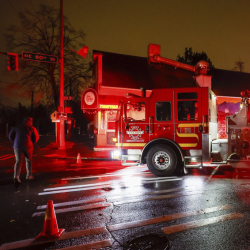
|
ORLANDO, Fla. (AP) -- A study released Monday of the 70 Football Bowl Subdivision schools that will participate in the upcoming college football bowl season showed continued academic progress, but that the gap between white and African-American players continues to persist.
The report by the University of Central Florida's Institute for Diversity and Ethics in Sport notes an overall Graduation Success Rate (a graduation rate which takes transfers into consideration) improvement from 67 percent to 68 percent for students on the 70 bowl teams.
A total of 97 percent of schools had at least a 50 percent GSR for football teams, up 6 percent from 2010.
Also, for the second straight year 99 percent of schools received a score higher than the target 925 on the NCAA's four-year Academic Progress Rate. Teams with a four-year APR of 925 or below face penalties including loss of scholarships.
"If I was an advisor of athletes on a college campus, I would feel good about myself overall," said primary study author Richard Lapchick. "One of the things about the report is that if you do well, it helps you stand out. If don't do well, hopefully the motivation is to continue to do better."
Lapchick hopes a lot of effort will go toward closing the racial disparity in graduation rates.
While the average GSR for African-American players rose from 60 percent to 61 percent from a year ago, it remains far behind the average for white players, which increased from 80 percent to 81 percent. In addition, 26 percent of the bowl teams (18 of 70) graduated fewer than half of their African-American players, while none graduated fewer than half of their white players.
If the schools with the highest overall GSR among bowl teams were paired in the national championship game, the matchup would feature Northwestern and Notre Dame.
But unlike past years, when BCS title game teams often had less than stellar academic credentials, both of this year's participants - LSU and Alabama - rank high, with APRs of 966 and 963, respectively.
LSU graduates 77 percent of its players overall and 91 percent and 69 percent of its white and African-American players, respectively. Alabama graduates 69 percent of its players overall 89 percent and 62 percent of its white and African-American players.
Lapchick said that, based on the poor overall record of bowl teams a decade ago, he wouldn't have thought that the teams competing in the national championship would have such strong academic credentials this fast.
"That brought a big smile to my face," he said.
In March, U.S. Secretary of Education Arne Duncan along with Lapchick and NAACP president and CEO Ben Jealous were critical of some of the poor graduation rates and APRs from schools that qualified for the men's NCAA basketball tournament. A Knight Commission analysis showed 10 of the 68 teams in the men's tournament last season didn't meet the NCAA's APR goal of being on track to graduate at least 50 percent of their players.
Duncan called for the NCAA to ban basketball teams with graduation rates below 40 percent from competing in the NCAA tournament.
The NCAA Board of Directors responded and during an August meeting voted to raise the APR standard across Division I to 930. It includes a provision that bans all teams below that from participating in the postseason, including all NCAA tournaments and football bowl games.
Previously, only when a school fell below a 900 APR had it been considered to be doing poor enough to receive a postseason ban.
If the new 930 APR standard had been in place for in March, 12 schools would not have qualified for the men's NCAA basketball tournament and seven teams, including Michigan and Louisville, would not have been eligible to play in this season's bowls.
Lapchick said he and Duncan would like to see the APR standard reflect a 60 percent graduation rate, but that the 930 threshold (equivalent to 50 percent) is a great start.
"Now there's pressure on the two of things coaches treasure- losing scholarships and not going to NCAA tournament or making bowl appearance. No coach wants to be subject to that," Lapchick said.
The GSR measures graduation rates at Division I schools after four years, and includes students transferring into the institutions. The GSR also allows schools to subtract student-athletes who leave prior to graduation as long as they would have been academically eligible to compete if they remained.
---
Online:
http://www.tidesport.org/
---
Follow Kyle Hightower on Twitter at http://twitter.com/khightower .
© 2011 The Associated Press. All rights reserved. This material may not be published, broadcast, rewritten or redistributed. Learn more about our Privacy Policy and Terms of Use.




















































































































































































































































































































































